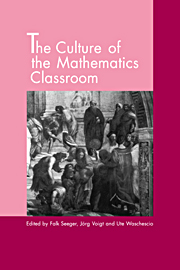Book contents
- Frontmatter
- Contents
- List of contributors
- Acknowledgments
- Introduction
- Part I Changing classroom culture
- Part II Classroom processes
- 5 Reasoning processes and the quality of reasoning
- 6 A constructivist perspective on the culture of the mathematics classroom
- 7 The culture of the mathematics classroom: Negotiating the mathematical meaning of empirical phenomena
- 8 The missing link: Social and cultural aspects in social constructivist theories
- Part III Epistemology and classroom culture
- Part IV Outlook
- Author index
- Subject index
6 - A constructivist perspective on the culture of the mathematics classroom
Published online by Cambridge University Press: 03 May 2010
- Frontmatter
- Contents
- List of contributors
- Acknowledgments
- Introduction
- Part I Changing classroom culture
- Part II Classroom processes
- 5 Reasoning processes and the quality of reasoning
- 6 A constructivist perspective on the culture of the mathematics classroom
- 7 The culture of the mathematics classroom: Negotiating the mathematical meaning of empirical phenomena
- 8 The missing link: Social and cultural aspects in social constructivist theories
- Part III Epistemology and classroom culture
- Part IV Outlook
- Author index
- Subject index
Summary
Several European theorists have argued that the social dimension is intrinsic to mathematical development (Balacheff 1986; Bauersfeld 1980; Bishop 1985; Brousseau 1984; Bartolini Bussi 1991). However, sociological perspectives have only come to the fore in mathematics education in the United States in the last few years. As recently as 1988, Eisenhart could write with considerable justification that mathematics educators
are accustomed to assuming that the development of cognitive skills is central to human development, [and] that these skills appear in a regular sequence regardless of context or content.
(1988: 101)The growing trend to go beyond purely psychological analyses is indicated by an increasing number of texts that question an exclusive focus on the individual learner (Brown, Collins, and Duguid 1989; Greeno 1991; Lave 1988a; Newman, Griffin, and Cole 1989; Nunes, Schliemann, and Carraher 1993; Saxe 1991). One of the central issues that emerge from this shift toward sociological perspectives is that of analyzing the culture of the mathematics classroom. In this regard, a range of closely related theoretical notions have been introduced, including the classroom discursive practice (Walkerdine 1988), the tradition of classroom practice (Solomon 1989), and the classroom microculture (Bauersfeld, Krummheuer, and Voigt 1988). We, for our part, have spoken of the classroom mathematics tradition (Cobb et al. 1992). This term was chosen to emphasize that the culture established in a mathematics classroom is in many ways analogous to a scientific research tradition.
- Type
- Chapter
- Information
- The Culture of the Mathematics Classroom , pp. 158 - 190Publisher: Cambridge University PressPrint publication year: 1998
- 39
- Cited by



